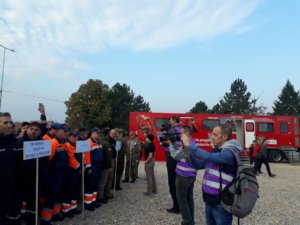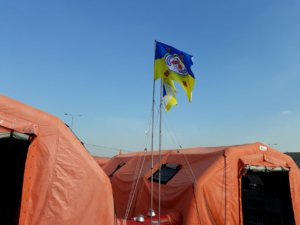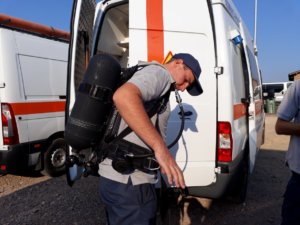BELGRADE – A group of 32 Ukrainian rescuers took part in NATO’s biggest civil emergency exercise, “Srbija 2018,” which was held in Serbia Oct. 8-11.
The Ukrainian team, consisting of a search-and-rescue group and a coordination group, took part in drills to test NATO’s response to a major earthquake. The exercise, which was held in and around Mladenovac, a town about 47 kilometers south of the Serbian capital Belgrade, in particular tested the coordination of military and civil groups’ responses to major disasters.
Ukraine’s search-and-rescue team practiced carrying out work in buildings destroyed by an earthquake, as well as emergency rescue work for traffic accidents or an accident at an industrial facility.
“The ultimate goal of rescuer training is that we are prepared to ensure that, at the moment when the emergency occurs, we are able to save lives with minimal risk to the lives of the rescuers,” said a representative of the Ukrainian team, Andrii Abramov, the head of the Diving Service Mobile Rescue Center in Ukraine.
The exercise was organized by NATO’s Euro-Atlantic Disaster Response Coordination Centre or EADRCC, and involved around 2,000 people from 36 countries
Ukrainian teams have participated in all eighteen civil emergency exercises organized by the EADRCC.
The co-director of the exercises, Claudiu Zoicas, a member of the EADRCC staff, said that the question is not if there will be a disaster, but when.
“EADRCC will continue to receive requests for assistance in the future,” Zoicas said. “We have been seeing this over the last few years, and we will continue to do what we have done in the past. This year the EADRCC will celebrate its 20th anniversary, and entering into its third decade, we see that there is still a lot to integrate into disaster response. Innovation is what we are doing. Teams work together, and this is a great opportunity to double capacity to work together and to integrate virtual reality and other technologies into our response to save lives.”
NATO Secretary General Jens Stoltenberg, opening the exercises, said the event gave NATO and Serbia an opportunity to put the past behind them.
“I realize that NATO remains controversial in Serbia,” Stoltenberg said. “The memories of the air campaign in 1999 are still painful for many, especially for those who lost their loved ones. The campaign was never against the Serbian people. It was to protect civilians in the wider region. Each innocent life lost was a tragedy that I deeply regret. I offer my condolences to the families and to all those who lost loved ones on both sides of the conflict. We must never forget the past. But we can move beyond it. And that is what NATO and Serbia are doing with our partnership, looking towards a better future,” said Stoltenberg during the opening ceremony.
Stoltenberg underlined that “Srbija 2018” was not “a military exercise, as NATO is not only a military alliance but a civilian exercise to deal with disasters and save lives.”
“Srbija 2018” is a testing exercise. It will show our strengths and our weaknesses. It will enable us to learn together and to get better together. It is also a great example of how Serbia’s partnership with NATO can bring concrete benefits to Serbia, to NATO, and to the whole region.”

The Ukrainian rescue team attends the opening ceremony of the “Srbija 2018” exercise on Oct. 8, 2018 in Mladenovac, Serbia. (Iryna Somer)

The press take pictures of the Ukrainian rescue team during the opening ceremony of the “Srbija 2018” exercise on Oct. 8, 2018 in Mladenovac, Serbia. (Iryna Somer)

The Ukrainian tents are set up on the “Srbija 2018” exercise ground on Oct. 8, 2018 in Mladenovac, Serbia. (Iryna Somer)

A Ukrainian team member shows off a radiation detection device at the “Srbija 2018” exercise on Oct. 8, 2018 in Mladenovac, Serbia. (Iryna Somer)

A Ukrainian team member tests respiratory apparatus with compressed air enough for 40 minutes used by Ukrainian team during exercises on Oct. 8, 2018. (Iryna Somer)



